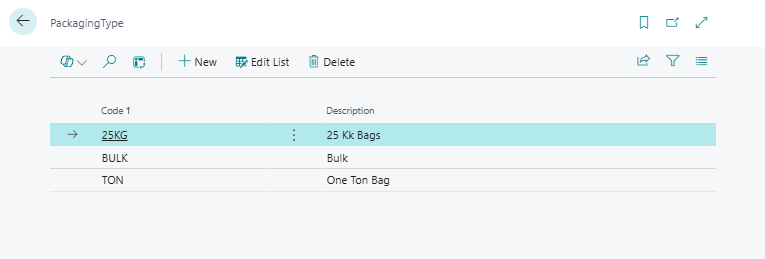Table of contents
- Table of contents
- Introduction
- CommLinc Setup
- Contract Types
- Pricing Statuses
- Futures Exchanges
- Items
- Seasons
- Transport Methods
- Packaging Types
Introduction
CommLinc Master Data setup is required to setup parameters and static data elements required for processing transactional data in CommLinc.
CommLinc Setup
The Setup table contains a set of master settings used to initiate default values and behaviors in CommLinc.

The first set of values specify the various number sequence ranges used for master data. Number Series can be managed through the standard No. Series functionality in Business Central.
Default Load Type specifies the what type of load will be created when a user creates a new load.
Default Load Size specifies the value to be used for Estimate Weight when a new Load is created.
Load in Transit Days is the number of days which will be added to the date loaded to default the date off loaded. This setting is ignored if Load Status determined by is set to Date.
Variant Mandatory indicates if Variant is Mandatory on loads. If this is set Loads can not be finalized without a variants.
Pricing Status Mandatory indicated if Pricing Status is mandatory on Contract Schedules.
Load Status Determined By managed the calculation load status, the options are Weight, Date or Variant. If Date is selected then offloaded date will not be defaulted from the loaded date and if Variant is selected the offloaded variant will not be defaulted from loaded variant. relevant dimensions.
Dimension 1 Mandatory On Load enforces the capture of Dimension Code 1 on Loads.
Dimension 2 Mandatory On Load enforces the capture of Dimension Code 2 on Loads.
Default Purchase Dimensions In the event of direct loads this triggers the automatic defaulting of Dimension Codes on Purchase allocations from the Sales allocation the load may be allocated to.
Company Customer No. is the Customer record in Customers used for the company. This is used to select Company Contacts for in particular E-Signatures on Contracts.
Option Premium Basis Element is used to specify which Basis Element Type to use to accumulate Option Premiums incurred when Options are used in Contract Pricing as a hedging instrument.
Contract Types
Contract types are used to drive behavior of Contract.

Editing a contract type will open the Contract Type page. On the Contract Type Record Is Hedged determines if Futures Trades can be associated Contract Schedules to calculate the Contract Schedule Price.
Hedge Category is a reporting field intended to allow grouping of contracts.
Allow Price Override indicates whether the calculated price on hedged contracts can be overridden.
Signature Workflow Required indicates whether signature workflow is required for the contract type.
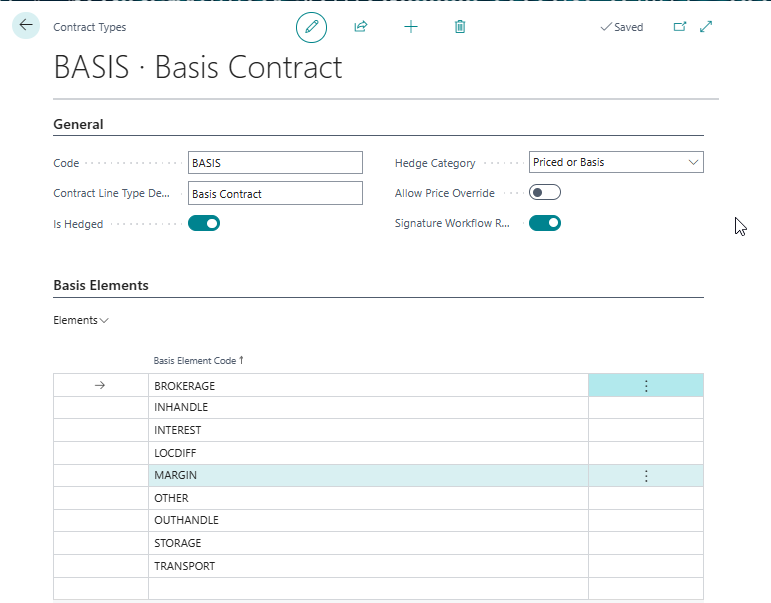
Per Contract Type a set of default Basis Elements can be defined. When new contract are creates a standard set of basis elements are generated as per defined on the Contract Type.
Pricing Statuses
Pricing Statuses effect invoicing and allocation behavior on Contract Schedules

Code is the unique identifier for the record.
Description describes the Pricing Status.
Allow Allocation indicates if Loads can be allocated to Contract Schedules with particular Pricing Status.
Allow Invoicing indicates if Load Allocations allocated to Contract Schedules with particular Pricing Status can be Invoiced.
Futures Exchanges
Futures Exchanges define the futures exchanges on which futures contracts can be traded in CommLinc

Futures Exchange Dealer
Futures Exchange Dealers define the individuals executing futures trades on the relevant Futures Exchanges.

Trader is linked to the standard BC Salespeople.Purchaser functionality.
Futures Instruments
Futures Instruments represent the various commodities traded on the different exchanges. Each Instrument is linked to a Futures Exchange and an Item, Items represent commodities in CommLinc.
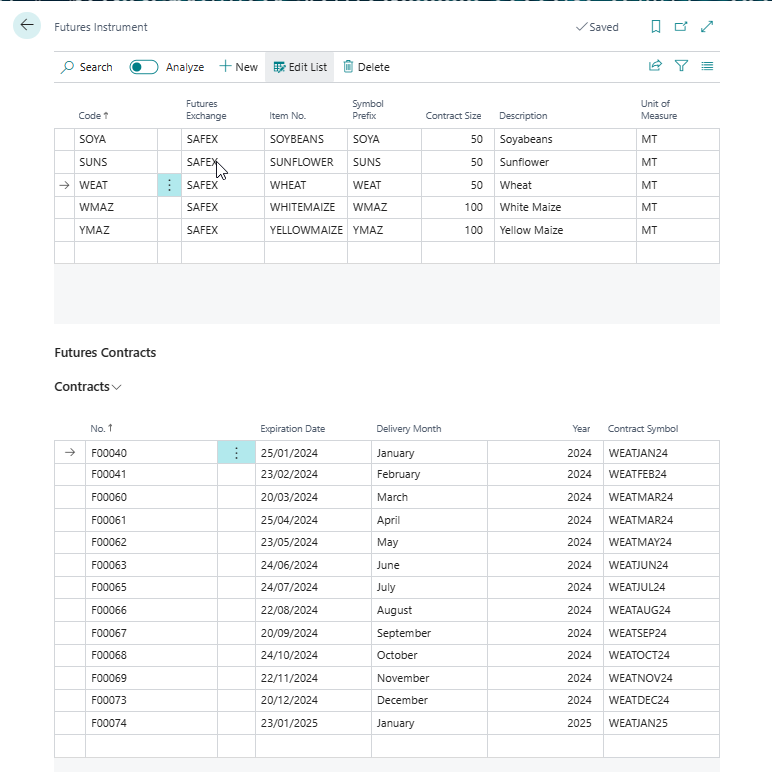
Contract Size is used by CommLinc to convert contracts traded exchange in quantities.
Futures Contracts
Each Futures Instrument has a set of Futures Contracts representing the actual contracts which can be traded on the exchange and represented in CommLinc as Futures Trades. The Contract Symbol is used to match trades imported from external trading applications or clearing house summaries.
Items
Items are used to represent commodities in CommLinc.
Three additional fields have been added to the Item Table: Default Variant, Default Variant Discount Table and Transport Loss Item.

Two important fields in the Items table are Type and Costing Method, care should be taken in selecting the appropriate values for these fields. Once transactions have been posted on an Item in Business Central the Type and Costing Method can not be modified. To manage stock in Business Central Item Type must be set to Inventory.
Default Variant specifies the default variant to be used when creating Contract Schedules. Generally grade discounts Variant Value Adjustments are calculated using the default variant as the base.
Default Variant Adjustment Table specifies the default variant adjustment table to be used when creating contract schedules.
Transport Loss Item specifies the related Item to be used when creating charges on Transport Purchase orders for transport losses. If Transport Loss items are created as service items charges for transport losses can be excluded from effecting stock. The price charged per unit of measure of the transport loss item should be updated periodically.
Item Variants
Item Variants are used to represent Commodity Grades.
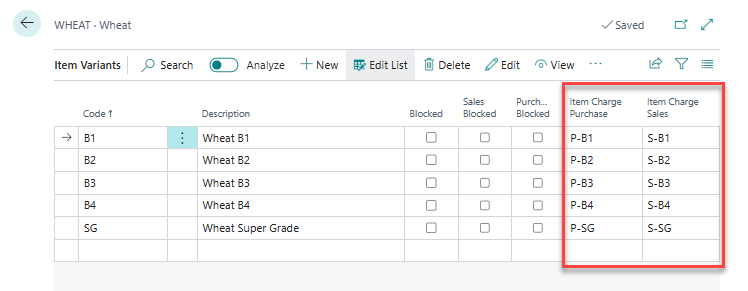
Two fields have been added to the Item Variant table, namely Item Charge Purchase and Item Charge Sales. These are standard Items Charges which indicate the Item Charges to be used when premiums or discounts are generated during Invoicing due to different Variants (grades) having been delivered than what was contracted.
Variant Value Adjustment Table
Each Variant Discount Table is associated with a particular Item and has a related set of records in the Variant Discount Matrix. The Variant Discount Matrix specifies the discount or premium applicable for each variant pair or the Item.
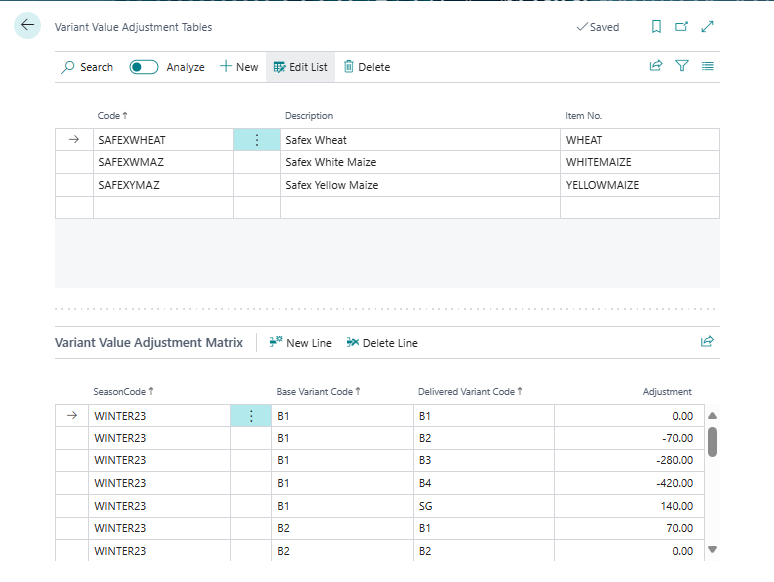
The Variant Value Adjustment Matrix above specifies, for example, for a purchase contract for Item Wheat Variant B1, and the producer delivers a Variant B2 a discount of 70 per ton at the base currency will be applied at invoicing. Should the producer deliver SG (Super Grade) a premium of 140 per ton at the base currency will be applied at invoicing. The relevant Item Charge Purchase defined on the Item Variant will be used for the charge line on the invoice, in the example above P-B1 and P-SG.
Item Attributes
Item Attributes are part of standard Business Central, but have been extended to include two additional fields. As with Variants, Item Charge Purchase and Item Charge Sales fields have been added. These are standard Items Charges in Business Central which can be edited in the Item Charges page. Item Attributes applicable to an Item can be defined on ether on an Item or for all Items in an Item Category. When capturing a Load the Grading function can be used to capture the values of attributes for the applicable load.

Item Charge Purchase and Item Charge Sale indicate the Item Charges to be used when premiums or discounts are generated during Invoicing due to Attribute values (grade values) within ranges specified in the Attribute Value Adjustment Matrix.
Attribute Value Adjustment Table
Each Attribute Value Adjustment Table is associated with a particular Item and has a related set of records in the Attribute Attribute Value Matrix. The matrix specifies the premium or discount applicable per season from the Peak Value .

The Variant Value Adjustment Matrix above specifies, for example, assume a purchase contract for Item Wheat Variant B1, and the producer delivers a Variant B2 a discount of 70 per ton at the base currency will be applied at invoicing. Should the producer deliver SG (Super Grade) a premium of 140 per ton at the base currency will be applied at invoicing. The relevant Item Charge Purchase defined on the Item Variant will be used for the charge line on the invoice, in the example above P-B1 and P-SG.
Attribute Mass Adjustment Table
CommLinc calculates Mass Adjustments based on the attribute values entered in the Grading screen for Loads. Through the Attribute Mass Adjustment Tables, records can be created with different Tolerance Percentages (%).
The Tolerance % represents the permissible value range for an attribute. When an attribute exceeds this tolerance, the system adjusts the mass by applying the percentage above the tolerance.
The Moisture Correction Indicator specifies whether the calculated factor should be based on a Moisture Correction basis.
Mass Adjustment tables can be specified on Items and Locations through Item Mass Adjustment Tables.
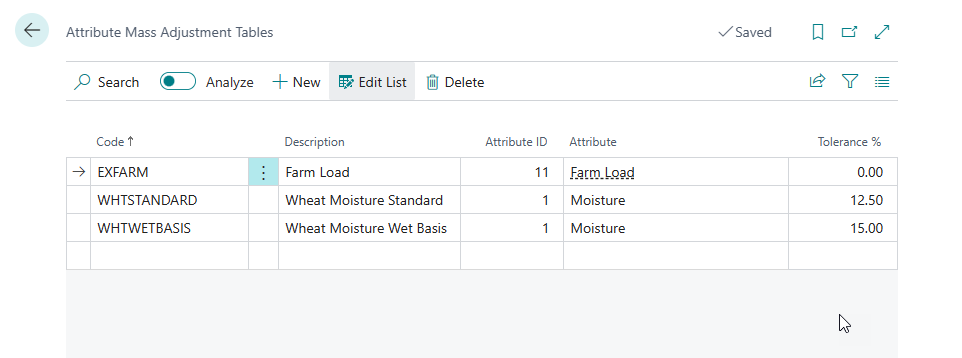
In the tables above, two Mass Adjustment Tables are defined for Moisture. WHTSTANDARD as a tolerance of 12.5% while WHTWETBASIS has a tolerance of 15%. Transactions where WHTSTANDARD are specified will be allowed to deliver Items with Moisture up to 12.5%, should product with 14% moisture be delivered it will result in a 1.5% mass adjustment. Items with WHTWETBASIS will be allowed to deliver up to 15% moisture.
Item Mass Adjustment Tables
Item Mass Adjustment tables specify the default mass adjustment tables are for Items or an Item and Location Combinations. An Item and Location combination takes precedence over a Item only record.
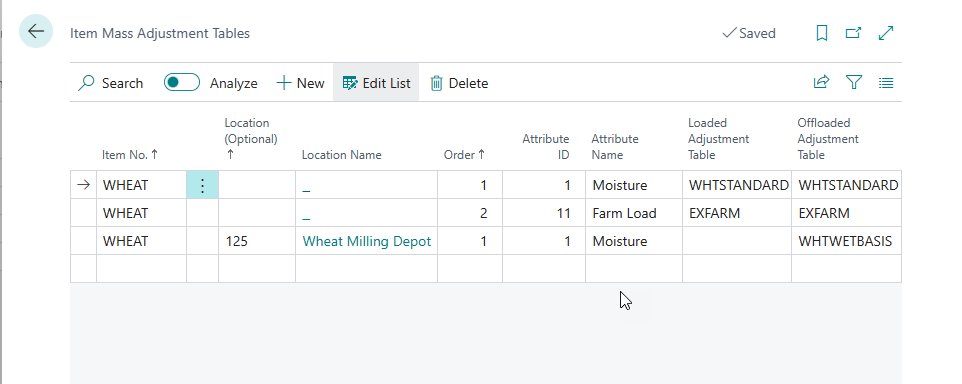
In the example above Wheat would by default use the WHTSTANDARD table for loading and offloading loads for all locations except Location Wheat Milling Depot which will accept loads using the WHTWETBASIS. The Wheat Milling Depot has no default mass adjustment table for loading loads.
Seasons
Seasons are used to specify commodity growing and marketing seasons by Item Category
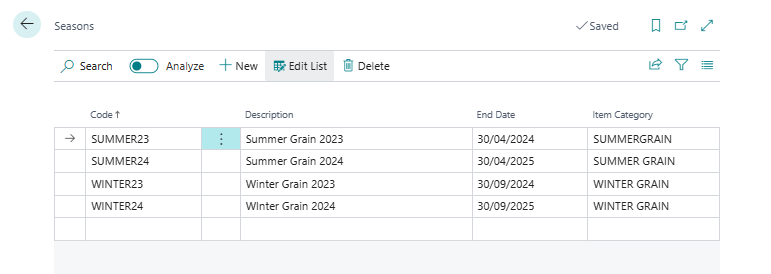
Attribute Value Adjustments and Variant Value Adjustments are indexed by season to facilitate pricing specifications per season.
Transport Methods
CommLinc extends the Transport Method table in Business Central to include Base Unit of Measure, Load Rate, Loss Tolerance % and Certificate Transfer. For each transport method a related set of records is added to define the Inbound and Outbound Item Charge per Item Category. Item Charges are used to define the Line Item Charge type when creating Purchase Orders and Invoices for transport in CommLinc.
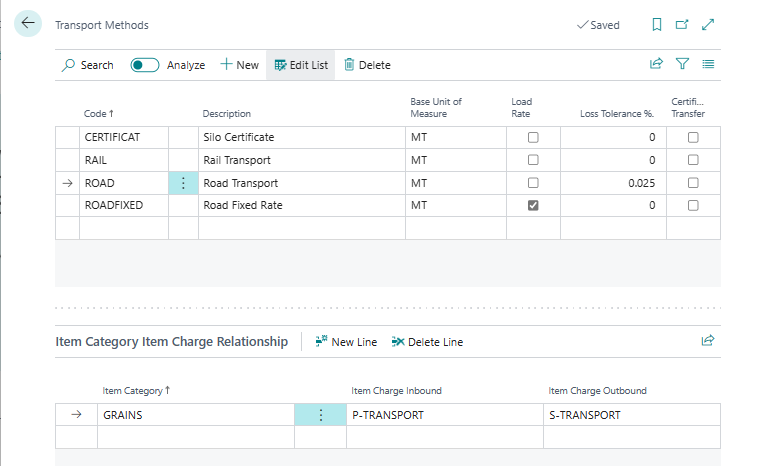
In the example above Road Fixed Rate is flagged as a Load Rate, meaning that the transport rate is calculated as a rate per load as opposed to the usual rate per unit of measure, normally rate per tons. Road transport has a transport loss tolerance of 0.025% which specifies the maximum transport loss which will be tolerated per load. Certificate Transfer indicates that the movement of product on contracts with this transport method will be via transfer of ownership via certificate or stock transfer, therefore there will be no physical transport involved.
Packaging Types
Packaging type is an infomation field which can be used on Contracts and Loads.
